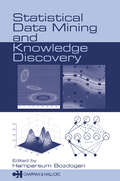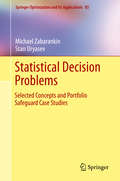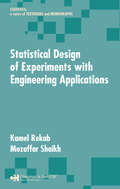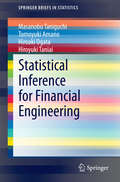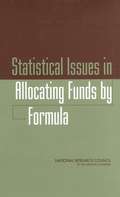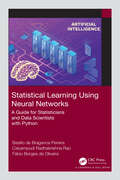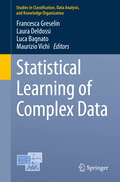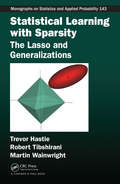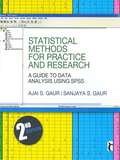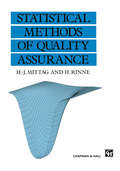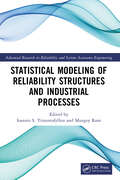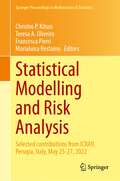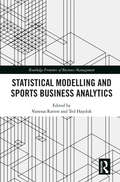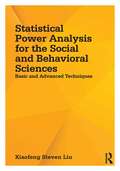- Table View
- List View
Statistical Data Mining and Knowledge Discovery
by Hamparsum BozdoganMassive data sets pose a great challenge to many cross-disciplinary fields, including statistics. The high dimensionality and different data types and structures have now outstripped the capabilities of traditional statistical, graphical, and data visualization tools. Extracting useful information from such large data sets calls for novel approache
Statistical Decision Problems
by Michael Zabarankin Stan UryasevStatistical Decision Problems presents a quick and concise introduction into the theory of risk, deviation and error measures that play a key role in statistical decision problems. It introduces state-of-the-art practical decision making through twenty-one case studies from real-life applications. The case studies cover a broad area of topics and the authors include links with source code and data, a very helpful tool for the reader. In its core, the text demonstrates how to use different factors to formulate statistical decision problems arising in various risk management applications, such as optimal hedging, portfolio optimization, cash flow matching, classification, and more. The presentation is organized into three parts: selected concepts of statistical decision theory, statistical decision problems, and case studies with portfolio safeguard. The text is primarily aimed at practitioners in the areas of risk management, decision making, and statistics. However, the inclusion of a fair bit of mathematical rigor renders this monograph an excellent introduction to the theory of general error, deviation, and risk measures for graduate students. It can be used as supplementary reading for graduate courses including statistical analysis, data mining, stochastic programming, financial engineering, to name a few. The high level of detail may serve useful to applied mathematicians, engineers, and statisticians interested in modeling and managing risk in various applications.
Statistical Design of Experiments with Engineering Applications
by Kamel Rekab Muzaffar ShaikhIn today's high-technology world, with flourishing e-business and intense competition at a global level, the search for the competitive advantage has become a crucial task of corporate executives. Quality, formerly considered a secondary expense, is now universally recognized as a necessary tool. Although many statistical methods are available for
Statistical Inference as a Bargaining Game
by Eduardo LeyA report from the International Monetary Fund.
Statistical Inference for Financial Engineering
by Masanobu Taniguchi Tomoyuki Amano Hiroaki Ogata Hiroyuki TaniaiThis monograph provides the fundamentals of statistical inference for financial engineering and covers some selected methods suitable for analyzing financial time series data. In order to describe the actual financial data, various stochastic processes, e. g. non-Gaussian linear processes, non-linear processes, long-memory processes, locally stationary processes etc. are introduced and their optimal estimation is considered as well. This book also includes several statistical approaches, e. g. , discriminant analysis, the empirical likelihood method, control variate method, quantile regression, realized volatility etc. , which have been recently developed and are considered to be powerful tools for analyzing the financial data, establishing a new bridge between time series and financial engineering. This book is well suited as a professional reference book on finance, statistics and statistical financial engineering. Readers are expected to have an undergraduate-level knowledge of statistics.
Statistical Inference via Data Science: A ModernDive into R and the Tidyverse (Chapman & Hall/CRC The R Series)
by Chester Ismay Albert Y. Kim Arturo ValdiviaStatistical Inference via Data Science: A ModernDive into R and the Tidyverse, Second Edition offers a comprehensive guide to learning statistical inference with data science tools widely used in industry, academia, and government. The first part of this book introduces the tidyverse suite of R packages, including ggplot2 for data visualization and dplyr for data wrangling. The second part introduces data modeling via simple and multiple linear regression. The third part presents statistical inference using simulation-based methods within a general framework implemented in R via the infer package, a suitable complement to the tidyverse. By working with these methods, readers can implement effective exploratory data analyses, conduct statistical modeling with data, and carry out statistical inference via confidence intervals and hypothesis testing. All of these tasks are performed by strongly emphasizing data visualization.Key Features in the Second Edition: Minimal Prerequisites: No prior calculus or coding experience is needed, making the content accessible to a wide audience. Real-World Data: Learn with real-world datasets, including all domestic flights leaving New York City in 2023, the Gapminder project, FiveThirtyEight.com data, and new datasets on health, global development, music, coffee quality, and geyser eruptions. Simulation-Based Inference: Statistical inference through simulation-based methods. Expanded Theoretical Discussions: Includes deeper coverage of theory-based approaches, their connection with simulation-based approaches, and a presentation of intuitive and formal aspects of these methods. Enhanced Use of the infer Package: Leverages the infer package for “tidy” and transparent statistical inference, enabling readers to construct confidence intervals and conduct hypothesis tests through multiple linear regression and beyond. Dynamic Online Resources: All code and output are embedded in the text, with additional interactive exercises, discussions, and solutions available online. Broadened Applications: Suitable for undergraduate and graduate courses, including statistics, data science, and courses emphasizing reproducible research. The first edition of the book has been used in so many different ways--for courses in statistical inference, statistical programming, business analytics, and data science for social policy, and by professionals in many other means. Ideal for those new to statistics or looking to deepen their knowledge, this edition provides a clear entry point into data science and modern statistical methods.
Statistical Issues in Allocating Funds by Formula
by Panel on Formula AllocationsIn 2000, the federal government distributed over $260 billion of funding to state and local governments via 180 formula programs. These programs promote a wide spectrum of economic and social objectives, such as improving educational outcomes and increasing accessibility to medical care, and many are designed to compensate for differences in fiscal capacity that affect governments’ abilities to address identified needs. Large amounts of state revenues are also distributed through formula allocation programs to counties, cities, and other jurisdictions. Statistical Issues in Allocating Funds by Formula identifies key issues concerning the design and use of these formulas and advances recommendations for improving the process. In addition to the more narrow issues relating to formula design and input data, the book discusses broader issues created by the interaction of the political process and the use of formulas to allocate funds.Statistical Issues in Allocating Funds by Formula is only up-to-date guide for policymakers who design fund allocation programs. Congress members who are crafting legislation for these programs and federal employees who are in charge of distributing the funds will find this book indispensable.
Statistical Learning Using Neural Networks: A Guide for Statisticians and Data Scientists with Python
by Basilio de Braganca Pereira Calyampudi Radhakrishna Rao Fabio Borges de OliveiraStatistical Learning using Neural Networks: A Guide for Statisticians and Data Scientists with Python introduces artificial neural networks starting from the basics and increasingly demanding more effort from readers, who can learn the theory and its applications in statistical methods with concrete Python code examples. It presents a wide range of widely used statistical methodologies, applied in several research areas with Python code examples, which are available online. It is suitable for scientists and developers as well as graduate students.Key Features: Discusses applications in several research areas Covers a wide range of widely used statistical methodologies Includes Python code examples Gives numerous neural network models This book covers fundamental concepts on Neural Networks including Multivariate Statistics Neural Networks, Regression Neural Network Models, Survival Analysis Networks, Time Series Forecasting Networks, Control Chart Networks, and Statistical Inference Results. This book is suitable for both teaching and research. It introduces neural networks and is a guide for outsiders of academia working in data mining and artificial intelligence (AI). This book brings together data analysis from statistics to computer science using neural networks.
Statistical Learning and Data Science
by Fionn Murtagh Mireille Gettler Summa Léon Bottou Bernard Goldfarb Catherine Pardoux Myriam TouatiData analysis is changing fast. Driven by a vast range of application domains and affordable tools, machine learning has become mainstream. Unsupervised data analysis, including cluster analysis, factor analysis, and low dimensionality mapping methods continually being updated, have reached new heights of achievement in the incredibly rich data wor
Statistical Learning of Complex Data (Studies in Classification, Data Analysis, and Knowledge Organization)
by Maurizio Vichi Francesca Greselin Laura Deldossi Luca BagnatoThis book of peer-reviewed contributions presents the latest findings in classification, statistical learning, data analysis and related areas, including supervised and unsupervised classification, clustering, statistical analysis of mixed-type data, big data analysis, statistical modeling, graphical models and social networks. It covers both methodological aspects as well as applications to a wide range of fields such as economics, architecture, medicine, data management, consumer behavior and the gender gap. In addition, it describes the basic features of the software behind the data analysis results, and provides links to the corresponding codes and data sets where necessary. This book is intended for researchers and practitioners who are interested in the latest developments and applications in the field of data analysis and classification. It gathers selected and peer-reviewed contributions presented at the 11th Scientific Meeting of the Classification and Data Analysis Group of the Italian Statistical Society (CLADAG 2017), held in Milan, Italy, on September 13–15, 2017.
Statistical Learning with Sparsity: The Lasso and Generalizations (Chapman & Hall/CRC Monographs on Statistics and Applied Probability)
by Trevor Hastie Robert Tibshirani Martin WainwrightDiscover New Methods for Dealing with High-Dimensional DataA sparse statistical model has only a small number of nonzero parameters or weights; therefore, it is much easier to estimate and interpret than a dense model. Statistical Learning with Sparsity: The Lasso and Generalizations presents methods that exploit sparsity to help recover the underl
Statistical Methods and Applications in Forestry and Environmental Sciences (Forum for Interdisciplinary Mathematics)
by Girish Chandra Raman Nautiyal Hukum ChandraThis book presents recent developments in statistical methodologies with particular relevance to applications in forestry and environmental sciences. It discusses important methodologies like ranked set sampling, adaptive cluster sampling, small area estimation, calibration approach-based estimators, design of experiments, multivariate techniques, Internet of Things, and ridge regression methods. It also covers the history of the implementation of statistical techniques in Indian forestry and the National Forest Inventory of India.The book is a valuable resource for applied statisticians, students, researchers, and practitioners in the forestry and environment sector. It includes real-world examples and case studies to help readers apply the techniques discussed. It also motivates academicians and researchers to use new technologies in the areas of forestry and environmental sciences with the help of software like R, MATLAB, Statistica, and Mathematica.
Statistical Methods and Applications in Insurance and Finance
by M'Hamed Eddahbi El Hassan Essaky Josep VivesThis book is theoutcome of the CIMPA School on Statistical Methods and Applications inInsurance and Finance, held in Marrakech and Kelaat M'gouna (Morocco) in April2013. It presents two lectures and seven refereed papers from the school,offering the reader important insights into key topics. The first of thelectures, by Frederic Viens, addresses risk management via hedging in discreteand continuous time, while the second, by Boualem Djehiche, reviews statisticalestimation methods applied to life and disability insurance. The refereed papersoffer diverse perspectives and extensive discussions on subjects includingoptimal control, financial modeling using stochastic differential equations,pricing and hedging of financial derivatives, and sensitivity analysis. Eachchapter of the volume includes a comprehensive bibliography to promote furtherresearch.
Statistical Methods for Financial Engineering
by Bruno RemillardWhile many financial engineering books are available, the statistical aspects behind the implementation of stochastic models used in the field are often overlooked or restricted to a few well-known cases. Statistical Methods for Financial Engineering guides current and future practitioners on implementing the most useful stochastic models used in f
Statistical Methods for Organizational Research: Theory and Practice
by Chris DewberryThis clearly written textbook clarifies the concepts underpinning descriptive and inferential statistics in organizational research. Acting as much more than a theoretical reference tool, step-by-step it guides readers through the various key stages of successful data analysis.Covering everything from introductory descriptive statistics to advanced inferential techniques such as ANOVA, multiple and logistic regression and factor analysis, this is one of the most comprehensive textbooks available. Using examples directly relevant to organizational research it includes practical advice on such topics as the size of samples required in research studies, using and interpreting SPSS, and writing up results. In helping readers to develop a sound understanding of statistical methods, rather than focusing on complex formulas and computations, this outstanding textbook is as appropriate for those who wish to refresh their knowledge as those new to the subject area.
Statistical Methods for Practice and Research: A Guide to Data Analysis Using SPSS (Response Books)
by Ajai S Gaur Sanjaya S GaurThere is a growing trend these days to use statistical methods to comprehend and explain various situations and phenomena in different disciplines. Managers, social scientists and practicing researchers are increasingly collecting information and applying scientific methods to analyze the data. The ability to use statistical methods and tools becomes a crucial skill for the success of such efforts. This book is designed to assist students, managers, academics and researchers in solving statistical problems using SPSS and to help them understand how they can apply various statistical tools for their own research problems. SPSS is a very powerful and user friendly computer package for data analyses. It can take data from most other file types and generate tables, charts, plots, and descriptive statistics, and conduct complex statistical analyses. After providing a brief overview of SPSS and basic statistical concepts, the book covers: - Descriptive statistics - t-tests, chi-square tests and ANOVA - Correlation analysis - Multiple and logistics regression - Factor analysis and testing scale reliability - Advanced data handling Illustrated with simple, practical problems, and screen shots, this book outlines the steps for solving statistical problems using SPSS. Although the illustrations are based on version 16.0 of SPSS, users of the earlier versions will find the book equally useful and relevant. Written in a reader-friendly, non-technical style, this book will serve as a companion volume to any statistics textbook.
Statistical Methods for the Information Professional: A Practical, Painless Approach to Understanding, Using, and Interpreting Statistics (Asist Monograph Ser.)
by Liwen VaughanIn this unique and useful book, the author clearly explains the statistical methods used in information science research, focusing on basic logic rather than mathematical intricacies. Her emphasis is on the meaning of statistics, when and how to apply them, and how to interpret the results of statistical analysis. Through the use of real-world examples, she shows how statistics can be used to improve services, make better decisions, and conduct more effective research. More than 80 helpful figures and tables, seven appendices, bibliography, and an index are included.
Statistical Methods of Quality Assurance
by Hans-Joachim. Mittag Horst RinneThis comprehensive textbook is a basic reference which should be recommended to students and teachers in engineering, technology and management as well as to the whole community of professionals already working in quality-related areas.The book aims to be a step-by-step introduction to statistical quality assurance. It has been specifically designed for self-study and includes over 100 fully solved exercises and worked examples. In addition to traditional quality control procedures the book also presents very carefully elaborated results of recent research in order to encourage their adoption into practice.
Statistical Modeling in Biomedical Research: Contemporary Topics and Voices in the Field (Emerging Topics in Statistics and Biostatistics)
by Ding-Geng Din Chen Yichuan ZhaoThis edited collection discusses the emerging topics in statistical modeling for biomedical research. Leading experts in the frontiers of biostatistics and biomedical research discuss the statistical procedures, useful methods, and their novel applications in biostatistics research. Interdisciplinary in scope, the volume as a whole reflects the latest advances in statistical modeling in biomedical research, identifies impactful new directions, and seeks to drive the field forward. It also fosters the interaction of scholars in the arena, offering great opportunities to stimulate further collaborations. This book will appeal to industry data scientists and statisticians, researchers, and graduate students in biostatistics and biomedical science. It covers topics in:Next generation sequence data analysisDeep learning, precision medicine, and their applicationsLarge scale data analysis and its applicationsBiomedical research and modelingSurvival analysis with complex data structure and its applications.
Statistical Modeling of Reliability Structures and Industrial Processes (ISSN)
by Mangey Ram Ioannis S. TriantafyllouThis reference text introduces advanced topics in the field of reliability engineering, introduces statistical modeling techniques, and probabilistic methods for diverse applications.It comprehensively covers important topics including consecutive-type reliability systems, coherent structures, multi-scale statistical modeling, the performance of reliability structures, big data analytics, prognostics, and health management. It covers real-life applications including optimization of telecommunication networks, complex infrared detecting systems, oil pipeline systems, and vacuum systems in accelerators or spacecraft relay stations. The text will serve as an ideal reference book for graduate students and academic researchers in the fields of industrial engineering, manufacturing science, mathematics, and statistics.
Statistical Modelling and Risk Analysis: Selected contributions from ICRA9, Perugia, Italy, May 25-27, 2022 (Springer Proceedings in Mathematics & Statistics #430)
by Christos P. Kitsos Teresa A. Oliveira Francesca Pierri Marialuisa RestainoThis volume covers the latest results on novel methods in Risk Analysis and assessment, with applications in Biostatistics (which is providing food for thought since the first ICRAs, covering traditional areas of RA, until now), Engineering Reliability, the Environmental Sciences and Economics. The contributions, based on lectures given at the 9th International Conference on Risk Analysis (ICRA 9), at Perugia, Italy, May 2022, detail a wide variety of daily risks, building on ideas presented at previous ICRA conferences. Working within a strong theoretical framework, supporting applications, the material describes a modern extension of the traditional research of the 1980s. This book is intended for graduate students in Mathematics, Statistics, Biology, Toxicology, Medicine, Management, and Economics, as well as quantitative researchers in Risk Analysis.
Statistical Modelling and Sports Business Analytics (Routledge Frontiers of Business Management)
by Vanessa Ratten Ted HaydukThis book introduces predictive analytics in sports and discusses the relationship between analytics and algorithms and statistics. It defines sports data to be used and explains why the unique nature of sports would make analytics useful. The book also explains why the proper use of predictive analytics includes knowing what they are incapable of doing as well as the role of predictive analytics in the bigger picture of sports entrepreneurship, innovation, and technology. The book looks at the mathematical foundations that enhance technical knowledge of predictive models and illustrates through practical, insightful cases that will help to empower readers to build and deploy their own analytic methodologies. This book targets readers who already have working knowledge of location, dispersion, and distribution statistics, bivariate relationships (scatter plots and correlation coefficients), and statistical significance testing and is a reliable, well-rounded reference for furthering their knowledge of predictive analytics in sports.
Statistical Models for Data Analysis
by Paolo Giudici Maurizio Vichi Salvatore IngrassiaThe papers in this book cover issues related to the development of novel statistical models for the analysis of data. They offer solutions for relevant problems in statistical data analysis and contain the explicit derivation of the proposed models as well as their implementation. The book assembles the selected and refereed proceedings of the biannual conference of the Italian Classification and Data Analysis Group (CLADAG), a section of the Italian Statistical Society.
Statistical Outliers and Related Topics
by Mir Masoom Ali Irfan Ali Haitham M. Yousof Rahmatullah ImonThe book is a collection of different aspects of outliers and related topics written by experts. Topics covered include definition of outliers, their sources, consequences, identification, computational and robustness issues, handling of outliers in diversified areas of statistics such as univariate and multivariate data, linear and generalized linear models, time series, linear functional and structural models, circular data, spatial data, big data, high dimensional data, multi-view data. The book emphasizes the importance of outliers, and will appeal to workers in Data Mining; which is one of the fastest-growing business applications of statistics. The book makes outlier detection methods widely usable by practitioners. Examples are drawn from various fields.
Statistical Power Analysis for the Social and Behavioral Sciences: Basic and Advanced Techniques
by Xiaofeng Steven LiuThis is the first book to demonstrate the application of power analysis to the newer more advanced statistical techniques that are increasingly used in the social and behavioral sciences. Both basic and advanced designs are covered. Readers are shown how to apply power analysis to techniques such as hierarchical linear modeling, meta-analysis, and structural equation modeling. Each chapter opens with a review of the statistical procedure and then proceeds to derive the power functions. This is followed by examples that demonstrate how to produce power tables and charts. The book clearly shows how to calculate power by providing open code for every design and procedure in R, SAS, and SPSS. Readers can verify the power computation using the computer programs on the book's website. There is a growing requirement to include power analysis to justify sample sizes in grant proposals. Most chapters are self-standing and can be read in any order without much disruption.This book will help readers do just that. Sample computer code in R, SPSS, and SAS at www.routledge.com/9781848729810 are written to tabulate power values and produce power curves that can be included in a grant proposal. Organized according to various techniques, chapters 1 – 3 introduce the basics of statistical power and sample size issues including the historical origin, hypothesis testing, and the use of statistical power in t tests and confidence intervals. Chapters 4 - 6 cover common statistical procedures -- analysis of variance, linear regression (both simple regression and multiple regression), correlation, analysis of covariance, and multivariate analysis. Chapters 7 - 11 review the new statistical procedures -- multi-level models, meta-analysis, structural equation models, and longitudinal studies. The appendixes contain a tutorial about R and show the statistical theory of power analysis. Intended as a supplement for graduate courses on quantitative methods, multivariate statistics, hierarchical linear modeling (HLM) and/or multilevel modeling and SEM taught in psychology, education, human development, nursing, and social and life sciences, this is the first text on statistical power for advanced procedures. Researchers and practitioners in these fields also appreciate the book‘s unique coverage of the use of statistical power analysis to determine sample size in planning a study. A prerequisite of basic through multivariate statistics is assumed.
